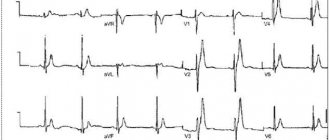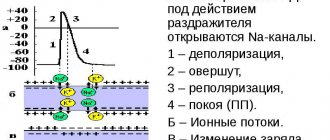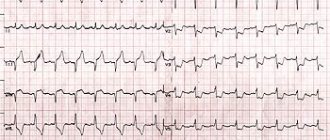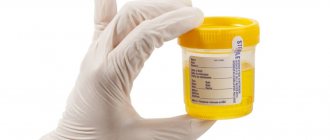Myocardial dystrophy is a complex pathological process in cells (cardiomyocytes), leading to depletion of energy reserves. At the same time, the ability to recover is not lost for a long time.
Changes occur at the level of cell metabolism. Failure of the energy synthesis process disrupts myocardial contractility. It is extremely difficult to identify clear manifestations at the initial stage. Myocardial dystrophy has been most studied in diseases accompanied by changes in metabolism (thyrotoxicosis, hypothyroidism, severe anemia, poison intoxication, vitamin deficiency).
Heart defects and myocarditis cause a combination of inflammation and degenerative changes in the myocardium. It is quite difficult to find out which of these processes prevails - inflammatory or dystrophic.
What happens in the myocardium?
Energy in myocardial cells is produced mainly during diastole. Biochemical processes occur in the presence of oxygen. Also necessary “ingredients” are vitamins, hormones, a complex of enzymes, glucose, lactic and pyruvic acids, fatty acids, ketone bodies, amino acids. Everything is delivered with blood.
The effect on the synthesis of nerve impulses has been proven. They regulate reactions and can intensify or slow them down. The heart has an important ability: it can synthesize energy from glucose with the participation of oxygen, but it is also capable of “holding out” for some time and extracting kilocalories from reserve glycogen without oxygen (anaerobic pathway).
Myocardial dystrophy manifests itself when all reserves are exhausted and the heart becomes energy deficient. If the process drags on for a long time and the body does not receive additional substances to “extract” energy, then normal cardiomyocytes are replaced by connective (scar) tissue, which is not capable of contracting.
Some metabolic changes lead to the inclusion of fatty complexes in the cardiac tissue. This pathology is called fatty degeneration of the myocardium. As a result, areas of “dead” tissue appear in the heart (but not necrosis, as in an acute heart attack!).
As compensation, the heart increases in volume without increasing contractility. The result is heart failure.
Dystrophic changes can be:
- local (focal), limited in size;
- diffuse if the process spreads throughout the muscle and in depth.
Myocardial dystrophy as a consequence of physical overexertion
Myocardial dystrophy can be a secondary disease that manifests itself against the background of other heart diseases that are not fully cured.
But often the heart muscle weakens due to too intense stress on the body. Excessive exercise is not beneficial, as organs begin to work at an accelerated rate and quickly wear out. Each person has his own body and his own physical capabilities, which allow him to perform some kind of work, do complex exercises and win competitions. Negative changes in the work of the heart occur not just from constant sports training, but precisely from the discrepancy between the loads and the individual capabilities of the body. If these possibilities and their limits are not taken into account, very soon the heart and other organs will begin to suffer serious failures. Regardless of what factors provoke the development of myocardial dystrophy, you need to take into account your personal characteristics and know the limit of physical stress that should not be crossed. For example, the same changes in the work of the heart muscle will occur in a trained athlete who runs a marathon at speed and in an ordinary person who is not keen on sports, who had to catch up with a leaving minibus at a pace that is unusual for his body. This suggests that every person should sensibly assess the capabilities of their muscles, respiratory system and heart, so as not to create unbearable working conditions for themselves or get carried away with overly complex and long workouts.
There are two types of heart strain: acute and chronic. Acute is the most dangerous, as it sometimes entails irreversible changes and complications that, if you are not attentive to your condition, can lead to death. These are hemorrhages in the heart, myocardial dystrophy or even a heart attack. If this type manifests itself in a mild form, then it is possible to immediately notice and stop any stress on the heart until it returns to normal. Heart pain manifests itself, and serious changes will be observed during an ECG check. A person may suffer from shortness of breath during any exertion, which was not the case before, and may also experience disturbances in the rhythm of the heartbeat.
If we talk about the chronic form, then most often this is actually myocardial dystrophy. It often manifests itself in fully trained athletes who have not been cured of some infectious disease that causes complications on the heart. These are tonsillitis, cholecystitis, caries, which is usually chronic. At the very beginning of the manifestation of dystrophy, sports fans do not feel any health problems and therefore do not change their lifestyle, continuing to train at the same rhythm. This is the danger of the disease, that it is difficult to identify it in the initial stages without undergoing appropriate checks and studies of the body.
Why does dystrophy occur?
There are 2 groups of reasons:
- heart disease that promotes metabolic disorders in cells (ischemic heart disease, myocarditis, cardiomyopathies); impaired coronary patency, inflammation and accumulation of waste in the tissue are important in the pathogenesis;
- extracardiac - through nervous regulation, disruption of hormone synthesis, disruption of the composition of blood cells affect the biochemical processes in the myocardium.
The second group of reasons include:
- consequences of chronic tonsillitis;
- poisoning with industrial and household poisons;
- decrease in the level of red blood cells in anemia of various etiologies and blood diseases;
- toxic side effects of medications (antibiotics, hormonal agents, cytostatics);
- endocrine pathology, especially of the adrenal glands and thyroid gland;
- lack of vitamins C (for scurvy) and B1 (for polyneuritis, alcoholism, enterocolitis);
- chronic kidney disease;
- long-term chronic respiratory diseases.
Dystrophy in athletes is caused by excessive physical activity and stress. Young people's passion for bodybuilding and all sorts of ways to pump up muscles leads to the early development of myocardial dystrophy.
Clinical manifestations
Symptoms of myocardial dystrophy are not typical for one disease.
Most often, metabolic changes are manifested by arrhythmias: from extrasystole to atrial fibrillation. After all, foci of altered cells block the normal paths of impulse propagation. The person feels an interruption in rhythm.
Pain in the heart area does not have a typical characteristic: stabbing, dull and aching, and is not necessarily related to physical activity.
Over time, signs of heart failure appear:
- dyspnea,
- increased fatigue,
- tachycardia,
- swelling on the feet.
Symptoms
You need to know the signs of myocardial dystrophy so that you can promptly seek medical help and begin treatment as soon as possible. The symptoms of the disease are:
- Shortness of breath and fatigue. This can manifest itself during severe stress that a person received constantly. The strange “behavior” of the body should alert you. You should never continue training if your heart is not behaving as usual. Shortness of breath can be bothersome even when walking or climbing stairs.
- Rapid or strong heartbeat. If earlier sports training did not cause any inconvenience, now the heart will actively react to any, even the smallest load. Strong muscle contraction is evidence of improper functioning of the organ.
- Dizziness, nausea and vomiting. All symptoms are similar to those of poisoning, even if the patient eats exclusively healthy food. These signs may indicate that the heart is not functioning properly.
- Muscle pain and weakness, which manifests itself constantly, even without much stress on the body.
- Loss of consciousness.
- Acute pain in the heart. It may indicate that myocardial dystrophy has acquired complications and leads to a heart attack. In this case, the pressure can drop sharply, and the person begins to suffocate from lack of oxygen. Sometimes you can observe a strong cardiac cough and wheezing in the chest area.
If such symptoms occur, the person should immediately stop any exercise and maintain maximum rest to allow the heart to recover. If pain occurs, it is important to immediately consult a doctor or call an ambulance, as this is an extremely serious situation. For several weeks you need to limit yourself to any sport and not participate in any competitions. The doctor can determine whether it is acceptable for the patient to start playing his favorite sport.
Diagnostics
The most common method of examining patients is electrocardiography, which provides sufficient information for the initial manifestations of cardiac dystrophy.
- The doctor at the functional diagnostics office determines metabolic changes, conduction disorders (blockades) and rhythm by the nature of the teeth when deciphering.
- During auscultation, one can indirectly suspect the onset of pathology by dull heart sounds.
- Histological studies are carried out in a living person extremely rarely. It is possible to take material for a biopsy for differential diagnosis with a tumor.
- Magnetic resonance imaging shows the degree of energy deficiency of the heart muscle.
Unlike acute myocardial infarction, biochemical blood samples do not show signs of tissue breakdown (transaminases, creatine phosphokinase, lactate dehydrogenase) and leukocytosis.
Only under a microscope can you see what fatty degeneration of the myocardium looks like
Diagnostic signs of diffuse and moderate changes on the ECG
The main method for detecting dystrophy in the heart muscle is to conduct a standard ECG and functional tests. In the presence of diffuse (widespread) changes, the following can be identified:
- decrease in ST;
- sinus tachycardia;
- extrasystoles;
- deformed or smoothed, sometimes negative T (with pheochromocytoma);
- low-amplitude waves, especially of the ventricular complex.
With obesity and hypothyroidism, the rhythm slows down, conduction blocks occur in the atria or ventricles, and QT prolongation occurs. With focal changes, such disturbances are detected only in 2-3 leads; they are usually weakly expressed. In order to discover the cause of myocardial dystrophy and distinguish it from diseases with similar symptoms, tests are performed. In typical cases, their results are:
- bicycle ergometry - no signs of ischemia during exercise;
- intake of potassium salts is normalized;
- Anaprilin – T positive or tends to normal;
- hyperventilation (fast breathing), sudden change in body position - T and ST decrease.
In addition to the ECG, when making a diagnosis, the appearance of systolic murmur over the base and apex, dull tones, and the absence of valvular defects on ultrasound are taken into account. If it is difficult to determine the disease, a radioisotope scan of the heart (scintigraphy) is performed.
In the resulting image, foci or diffuse changes are visible in myocardial dystrophy. They manifest themselves in the form of weak accumulation of drugs, which reflects a decrease in the number of functioning cells.
If all these methods turn out to be uninformative, then they resort to myocardial biopsy.
Treatment
Treatment of myocardial dystrophy requires correction of changes caused by the underlying disease. At an early stage, they are reversible and completely allow the restoration of damaged cells.
- The patient is advised to avoid heavy physical activity and strength training.
- Organize a nutritious diet with sufficient meat and fruit. Stop any “starvation” diets or vegetarianism.
- Reconsider your attitude towards smoking and alcohol. Continuing bad habits is no use for treatment. It won't be effective.
- An endocrinologist prescribes drugs to correct the balance of thyroid hormones or iodine drugs to inhibit hyperfunction.
- Vitamin deficiency is treated with high doses of vitamins, which include group B with folic acid, A, C.
- For anemia, iron-containing medications and red blood cell transfusion are necessary.
- Patients with chronic tonsillitis undergo removal of the glands if they cannot be completely sanitized and cause frequent exacerbations.
- The following drugs have a specific therapeutic effect on myocardial nutrition: Panangin, Asparkam, Mildronate, Retabolil. Currently, Riboxin and Cocarboxylase have lost their importance.
The drug restores damaged myocardial cells
To treat arrhythmias, drugs from the β-blocker group are used, which inhibit the passage of calcium through the channels. Sedatives, mainly of plant origin, are indicated.
Permissible physical activity for myocardial dystrophy
Myocardial dystrophy requires partial rest so as not to overload the heart muscle.
After all, this can lead to serious complications and even death. But no one says that you need to give up sports completely. To treat the heart muscle, special physical therapy is provided, which allows you to develop the organ and thereby quickly treat it from the disease. At the same time, the “dosage” of such physical education should be prescribed on a strictly individual basis, since what is suitable for one person can be dangerous or even fatal for another. They use gymnastic exercises that exclude strength exercises, so as not to strain the heart. In addition to gymnastics, it is recommended to walk every day and gradually increase the walking time. The duration of gymnastics should not be more than half an hour, since patients need rest. The exercises used are those aimed at intense movements of the limbs. Breathing exercises are required to develop and train the diaphragm. All exercises must be done so that the load on parts of the body is distributed evenly.
In addition to therapeutic exercises, you can go on walking excursions, play volleyball, but no more than half an hour. Bathing and swimming will also be useful, but in moderate doses. In winter it is permissible to skate and ski. With myocardial dystrophy, it is advisable to spend the day actively, alternating physical activity with rest. One-time intense workouts that put the heart at risk by forcing it to work at full capacity should be avoided. Moderate body training will be beneficial if the disease has not taken an acute form, which requires only rest with limited movement.










